√画像をダウンロード yield to maturity formula for bonds 322149-Yield to maturity calculator for bonds
Definition The yield to maturity (YTM) of a bond is the internal rate of return (IRR) if the bond is held until the maturity date In other words, YTM can be defined as the discount rate at which the present value of all coupon payments and face value is equal to the current market price of a bondOn the other, the bond valuation formula for deep discount bonds or zerocoupon bonds can be computed simply by discounting the par value to the present value, which is mathematically represented as,Use the formula, where, P = the bond price, C = the coupon payment, i = the yield to maturity rate, M = the face value and n = the total number of coupon payments If you plug the 1125 percent YTM into the formula to solve for P, the price, you get a price of $ A lower yield to maturity will result in a higher bond price
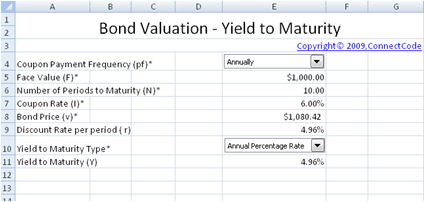
Free Bond Valuation Yield To Maturity Spreadsheet
Yield to maturity calculator for bonds
Yield to maturity calculator for bonds-This price is somewhat close to the current price of the bond, which is $10There are two common measures of yield current yield and yield to maturity Current yield equals the annual interest payment divided by the current market price of the security Yield to maturity is the internal rate of return of a security which means it is the rate an investor will earn by purchasing the security at its current price and receiving all future cash flows, such as coupon payments till maturity and the maturity value
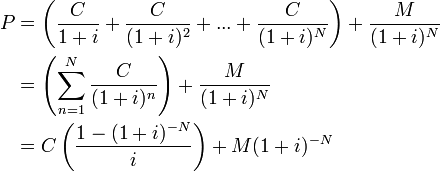


Valuing Bonds Boundless Finance
The approximate yield to maturity for the bond is 1333% which is above the annual coupon rate by 3% Using this value as yield to maturity (r), in the present value of the bond formula, would result in the present value to be $;Because yield is a function of price, changes in price result in bond yields moving in the opposite direction There are two ways of looking at bond yields current yield and yield to maturity Current Yield This is is the annual return earned on the price paid for a bond It is calculated by dividing the bond's coupon rate by its purchase priceCurrent Yield to Maturity Calculator Inputs Current Bond Trading Price ($) The price the bond is trading at today Bond Face Value/Par Value ($) The par value or face value of the bond Years to Maturity The numbers of years until bond maturity
The current market yield or 'yield to maturity' on a bond can be found out if the price of the bond is known In case of a (1) Perpetual Bond Yield = Annual Interest Payment/Price of Bond = I/V If the coupon rate of interest on a Rs 1000 per value perpetual bond is 7% what is its current yield if the bond's market price is Rs 700?The term "yield to maturity" or YTM refers to the return expected from a bond over its entire investment period until maturity YTM is used in the calculation of bond price wherein all probable future cash flows (periodic coupon payments and par value on maturity) are discounted to present value on the basis of YTMRate = Nominal coupon interest rate
The current yield is a measure of the income provided by the bond as a percentage of the current price There is no builtin function to calculate the current yield, so you must use this formula For the example bond, the current yield is 2% Note that the current yield only takes into account the expected interest paymentsN = Years to maturityThe formula for calculating the yield to maturity on a zerocoupon bond is Yield To Maturity=(Face Value/Current Bond Price)^(1/Years To Maturity)−1 Consider a $1,000 zerocoupon bond that has
:max_bytes(150000):strip_icc()/dotdash_Final_Current_Yield_vs_Yield_to_Maturity_Nov_2020-01-c4613a2a2029466a960d9e3594841a03.jpg)


Current Yield Vs Yield To Maturity



Bond Yield Calculator
The approximate yield to maturity for the bond is 1333% which is above the annual coupon rate by 3% Using this value as yield to maturity (r), in the present value of the bond formula, would result in the present value to be $;Yield can also be represented in the form of current yield Let's again look at our yield to maturity example to understand what is the current yield Current yield, by definition, is the annual rate of return that you receive for the price paid for that bond The formula of current yield Coupon rate / Purchase priceFormula for Calculating the Effective Yield The formula for calculating the effective yield on a bond purchased Effective Yield = 1 (i/n) n – 1 Where i – The nominal interest rate on the bond;



Calculating The Yield To Maturity Ytm Of A Bond Financial Management



Solved 2 The Market Price Of A 4 10 Year Bond Is 800 Chegg Com
Yield to Maturity, YTM Definition The yield to maturity (YTM) of a bond is the internal rate of return (IRR) if the bond is held until the Formula To solve the equation above, the financial calculator or MS Excel is needed Annual YTM = (1 Semiannual Example A private investor has1 c (1 r) 1 c (1 r) 2 c (1 r) Y B (1 r) Y = P where c = annual coupon payment (in dollars, not a percent) Y = number of years to maturity B = par value P = purchase price You should try to form a mental picture of what this equation is sayingThe calculator uses the following formula to calculate the yield to maturity P = C×(1 r)1 C×(1 r)2 C×(1 r)Y B×(1 r)Y Where P is the price of a bond, C is the periodic coupon payment, r is the yield to maturity (YTM) of a bond, B is the par value or face value of a bond, Y is the number of years to maturity



Valuing Bonds Boundless Finance



What You Must Know On Bond Valuation And Yield To Maturity Acca Afm Got It Pass
This price is somewhat close to the current price of the bond, which is $10A tutorial for calculating and comparing bond yields nominal and current yield, yield to maturity (aka true or effective yield), yield to call, yield to put, yield to sinker, yield to average life, yield to worst, and taxable or bond equivalent yield, and determining the interest rate for zero coupon bonds — includes formulas and examplesYield To Maturity (YTM) The IRR on an interest bearing instrument Law of One Price All interest bearing instruments are priced to fit the term structure This is accomplished by modifying the asset price The modified price creates a new yield, which fits the term structure The new yield is called the yield to maturity (YTM) Example $1,000 Treasury bond expires in 5 years



Best Excel Tutorial How To Calculate Yield In Excel
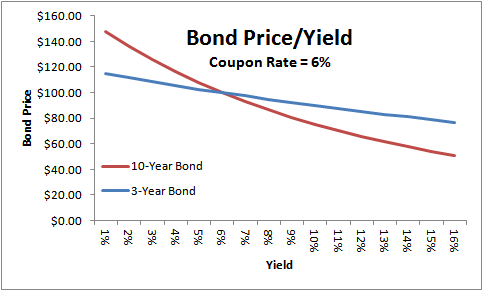


Bond Yields Nominal And Current Yield Yield To Maturity Ytm With Formulas And Examples
Bonds trading above par value, or premium bonds, have a yield to maturity lower than the coupon rate The spot rate is calculated by finding the discount rate that makes the present value (PV) ofThe formula for current yield is expressed as expected coupon payment of the bond in the next one year divided by its current market price Mathematically, it is represented as, Current Yield = Coupon Payment in Next One Year / Current Market Price * 100% Example of Bond Yield Formula (With Excel Template)Relevance and Use The relevance of the Current yield formula can be seen in evaluating multiple bonds of the same risk & maturity The coupon rate of a bond usually remains the same;



Current Yield Meaning Importance Formula And More



How To Use The Excel Yield Function Exceljet
The yield to maturity (YTM), book yield or redemption yield of a bond or other fixedinterest security, such as gilts, is the (theoretical) internal rate of return (IRR, overall interest rate) earned by an investor who buys the bond today at the market price, assuming that the bond is held until maturity, and that all coupon and principal payments are made on scheduleF = Face value;Yield to Maturity Formula refers to the formula that is used in order to calculate total return which is anticipated on the bond in case the same is held till its maturity and as per the formula Yield to Maturity is calculated by subtracting the present value of security from face value of security, divide them by number of years for maturity and add them with coupon payment and after that dividing the resultant with sum of present value of security and face value of security divided by 2
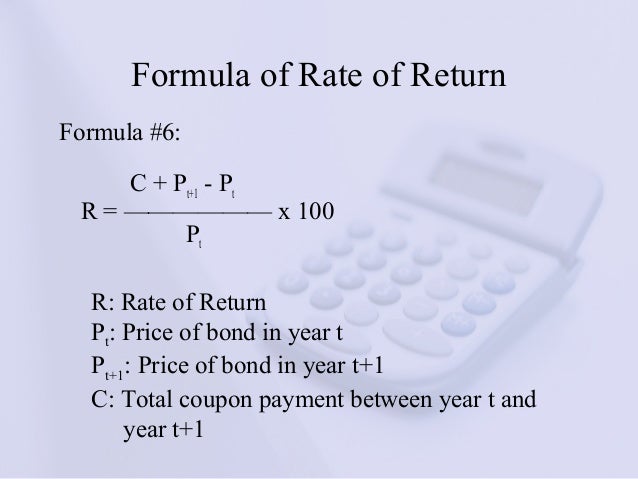


The Yield To Maturity And Bond Equivalent Yield Fidelity



Bonds Yield To Worst Current Yield Vs Yield To Maturity
For the bond is 15% and the bond will reach maturity in 7 years The formula for determining approximate YTM would look like below The approximated YTM on the bond is 1853% Importance of Yield to MaturityFormula to Calculate Bond Price The formula for bond pricing is basically the calculation of the present value of the probable future cash flows, which comprises of the coupon payments and the par value, which is the redemption amount on maturity The rate of interest which is used to discount the future cash flows is known as the yield to maturity (YTM)The following formula can be used to calculate it Where C – Interest/coupon payment FV – Face value of the security PV – Present value/price of the security t – How many years it takes the security to reach maturity The overall expected return for an investor if the bond is held to maturity is known as yield to maturity (YTM)



Bonds Spot Rates Vs Yield To Maturity Youtube



Bond Yield To Maturity Ytm Calculator
Divide this into the yield on the taxfree bond to find out the taxequivalent yield For example, if the bond in question yields 3 percent, use the equation (30 / 75) = 4 percent If you plug different tax rates into the equation above, you will see that the higher your tax rate, the higher the taxequivalent yield, illustrating how taxfreeN = No of periods till maturity;Formula to Calculate Bond Price The formula for bond pricing is basically the calculation of the present value of the probable future cash flows, which comprises of the coupon payments and the par value, which is the redemption amount on maturity The rate of interest which is used to discount the future cash flows is known as the yield to maturity (YTM)



An Introduction To Bonds Bond Valuation Bond Pricing



How To Calculate Yield For A Callable Bond The Motley Fool
YieldtoMaturity (YTM) Formula for Bonds using Microsoft Excel;Yield to Maturity is calculated using the formula given below YTM =Coupon Prorated Discount /(Redemption Price Purchase Price)/2 YTM = 630 ($1350 / 5) / ($104 $90) / 2Yield To Maturity= (Face Value/Current Bond Price)^ (1/Years To Maturity)−1 Consider a $1,000 zerocoupon bond that has two years until maturity The bond is currently valued at $925, the price at
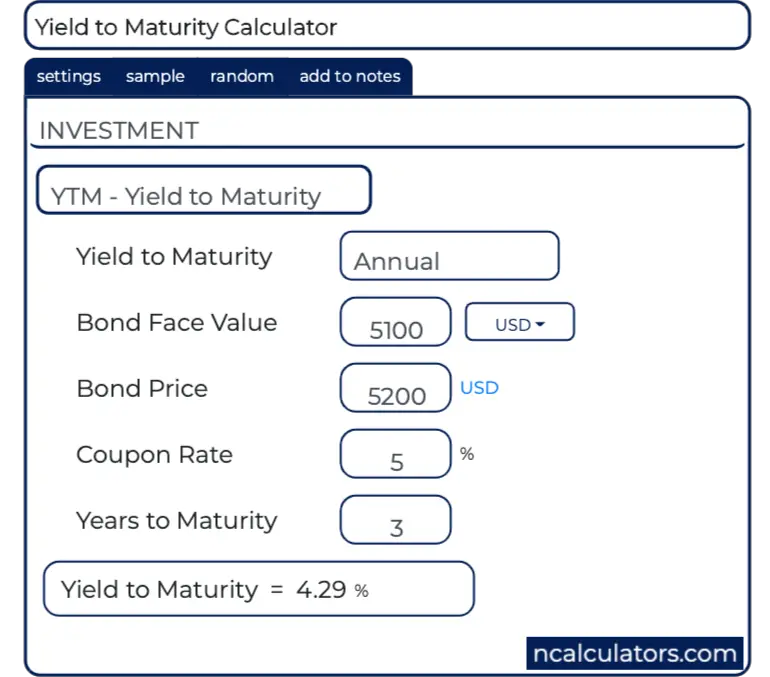


Yield To Maturity Ytm Calculator



What Is A Zero Coupon Bond
Since the current price of the bond is INR 950 The required yield to maturity is close to 6% At 5865% the price of the bond is INR Hence, the estimated yield to maturity for this bond is 5865% Importance of yield to maturity Yield to maturity helps in estimating whether buying bonds (fixed income securities) is a good investmentIt's difficult to calculate the exact YTM, but in the formulas below we'll look at how you can calculate the approximate yield to maturity of a bond Yield to Maturity Formula YTM = \dfrac{ C \dfrac{FP}{n} }{ \dfrac{FP}{2}} C = Coupon/interest payment;The following formula can be used to calculate it Where C – Interest/coupon payment FV – Face value of the security PV – Present value/price of the security t – How many years it takes the security to reach maturity The overall expected return for an investor if the bond is held to maturity is known as yield to maturity (YTM)



How To Calculate Yield To Maturity Definition Equation Example Financial Accounting Class Video Study Com



Finance Slide Evaluating Bond Prices And Returns
Yield to Maturity (YTM) for a bond is the total return, interest plus capital gain, obtained from a bond held to maturity It is expressed as a percentage and tells investors what their return on investment will be if they purchase the bond and hold on to it until the bond issuer pays them backIf you pay $1,000 for this bond, your yield to maturity will be exactly 6 percent, as you will receive the exact amount of money you originally paid for the bond However, if you only pay $900 for the bond, your yield to maturity will be greater because, in addition to the 6 percent interest, you'll earn a capital gain of $100Example of Yield to Maturity Formula The price of a bond is $9 with a face value of $1000 which is the face value of many bonds Assume that the annual coupons are $100, which is a 10% coupon rate, and that there are 10 years remaining until maturity This example using the approximate formula would be


Microsoft Excel Bond Yield Calculations Tvmcalcs Com
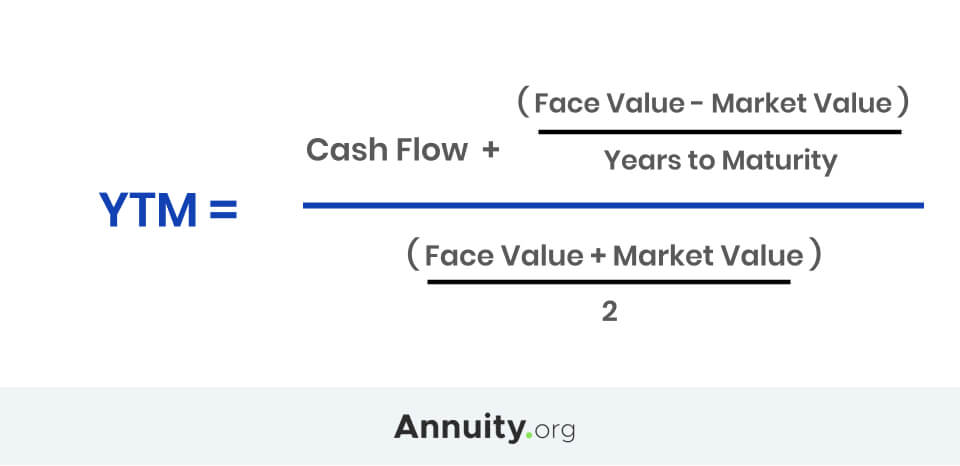


Yield Curve How Yield Curve Changes Affect Annuities
Y T M = Face Value Current Price n − 1 where n = number of years to maturity Face value = bond's maturity value or par value Current price = the bond's price today \begin{aligned} &YTMF = Face / Par value of bond, r = Yield to maturity (YTM) and;Yield to maturity (YTM) is the annual return that a bond is expected to generate if it is held till its maturity given its coupon rate, payment frequency and current market price Yield to maturity is essentially the internal rate of return of a bond ie the discount rate at which the present value of a bond's coupon payments and maturity value is equal to its current market price



Bond Yield Calculator



Berk Chapter 8 Valuing Bonds
The yield to maturity formula is very simple if the par value equals the market value At that point, the yield to maturity is simply the coupon rate However, this is rarely the case Therefore, for the many times the market value doesn't equal the par value, the yield to maturity is the same as calculating the IRR(Internal Rate of Return) on any investment It is a calculation measuring the cash flows starting with the purchase of the bond, the coupon payments while holding the bond, andFormula for Calculating the Effective Yield The formula for calculating the effective yield on a bond purchased Effective Yield = 1 (i/n) n – 1 Where i – The nominal interest rate on the bond;The yield to maturity formula is used to calculate the yield on a bond based on its current price on the market The yield to maturity formula looks at the effective yield of a bond based on compounding as opposed to the simple yield which is found using the dividend yield formula
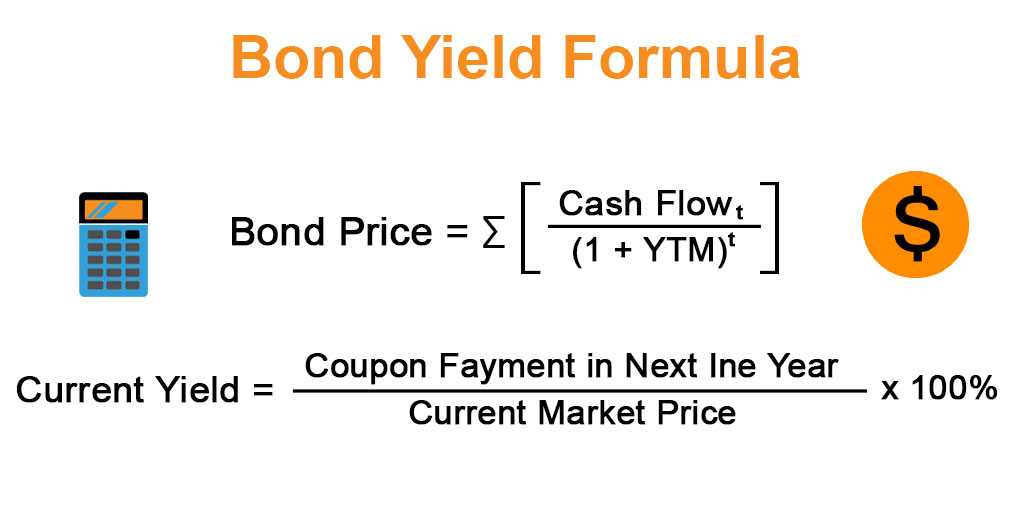


Bond Yield Formula Calculator Example With Excel Template



What Is A Zero Coupon Bond
However, the changes in interest rate markets encourage investors to constantly change their required rate of return (Current yield) As a result, bond prices fluctuate, and prices increase/decrease as per theThe par value of the bond is Rs 1,000 Its current yield is Current Yield = 80/100 = 08 or 8% Yield on bonds is more commonly calculated to the date of maturity (YTM), ie, the percentage yield that will be earned on bond from the purchase date to maturity dateN – The number of coupon payments received in each year Practical Example Assume that you purchase a bond with a nominal coupon rate of 7%
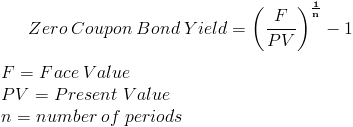


Zero Coupon Bond Yield Formula With Calculator



How To Calculate Bond Prices And Yields On The Series 7 Exam Dummies
If you look at the yield to maturity formula, you will see that the calculation of YTM assumes that all coupon payments are invested back into the bond so that the present value of cash flows equals the bond's market price in current times The rate at which cash flows are assumed to be invested is called YTM of the bondMaturity = Maturity date;If a bond is "callable," it means that the issuer has the right to buy the bond back at a predetermined date before its full maturity date The call could happen at the bond's face value, or the
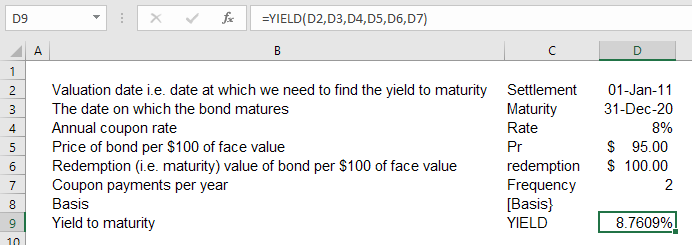


Yield To Maturity Ytm Definition Formula And Example



Bond Valuation Pricing And Calculator Finpricing
YTM = Yield(settlement, maturity, rate, price, redemption, frequency, basis) All dates are expressed either as quotes or as cell references (eg, "1/5/13", A1) Settlement = Settlement date;To apply the yield to maturity formula, we need to define the face value, bond price and years to maturity For example, if you purchased a $1,000 for $900 The interest is 8 percent, and it will mature in 12 years, we will plugin the variablesN – The number of coupon payments received in each year Practical Example Assume that you purchase a bond with a nominal coupon rate of 7%



How To Calculate Yield For A Callable Bond The Motley Fool


Learn To Calculate Yield To Maturity In Ms Excel
You can use Excel's RATE function to calculate the Yield to Maturity (YTM) Check out the image below The syntax of RATE function RATE (nper, pmt, pv, fv, type, guess) Here, Nper = Total number of periods of the bond maturity Years to maturity of the bond is 5 years But coupons per year is 2 So, nper is 5 x 2 = 10Using the YTM formula, the required yield to maturity can be determined 950 = 40/(1YTM)^1 40/(1YTM)^2 40/(1YTM)^3 1000/(1YTM)^3 We can try out the interest rate of 5% and 6%



Yield To Maturity Formula Ppt Video Online Download
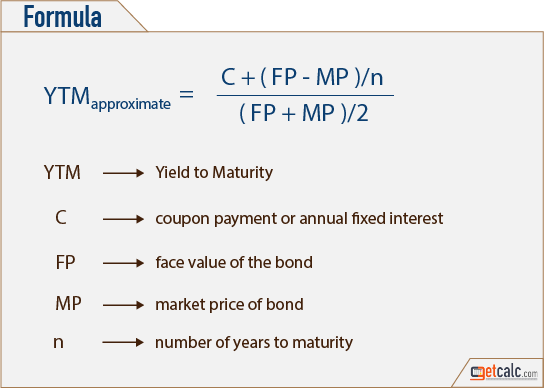


Ytm Yield To Maturity Calculator



Bond Yield Calculator


1



Ppt Chapter 10 Powerpoint Presentation Free Download Id



How To Calculate Bond Price And Yield To Maturity Pdf Free Download



What Is The Difference Between Irr And The Yield To Maturity The Motley Fool



Yield To Maturity
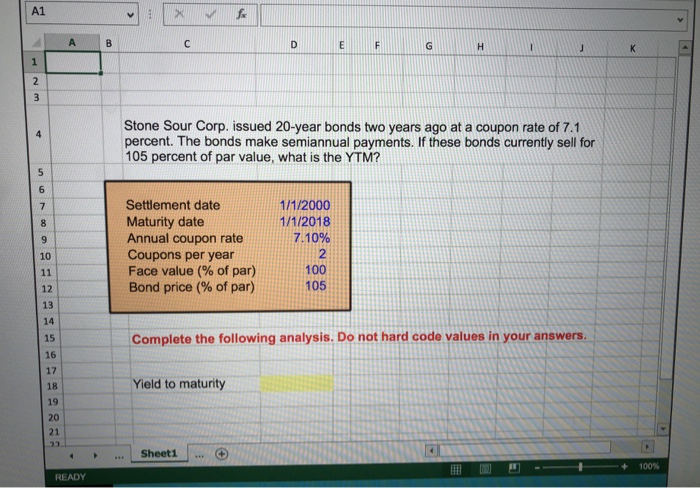


Solved Calculate The Ytm Using Excel Formula And Cells S Chegg Com



How To Calculate Yield To Maturity 9 Steps With Pictures


Coupon Bond Formula Drone Fest



What Is Yield To Maturity How To Calculate It Scripbox
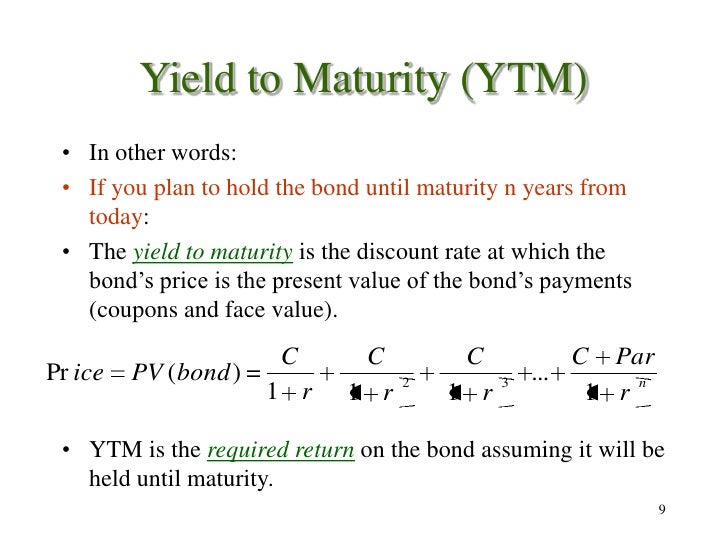


Ch7
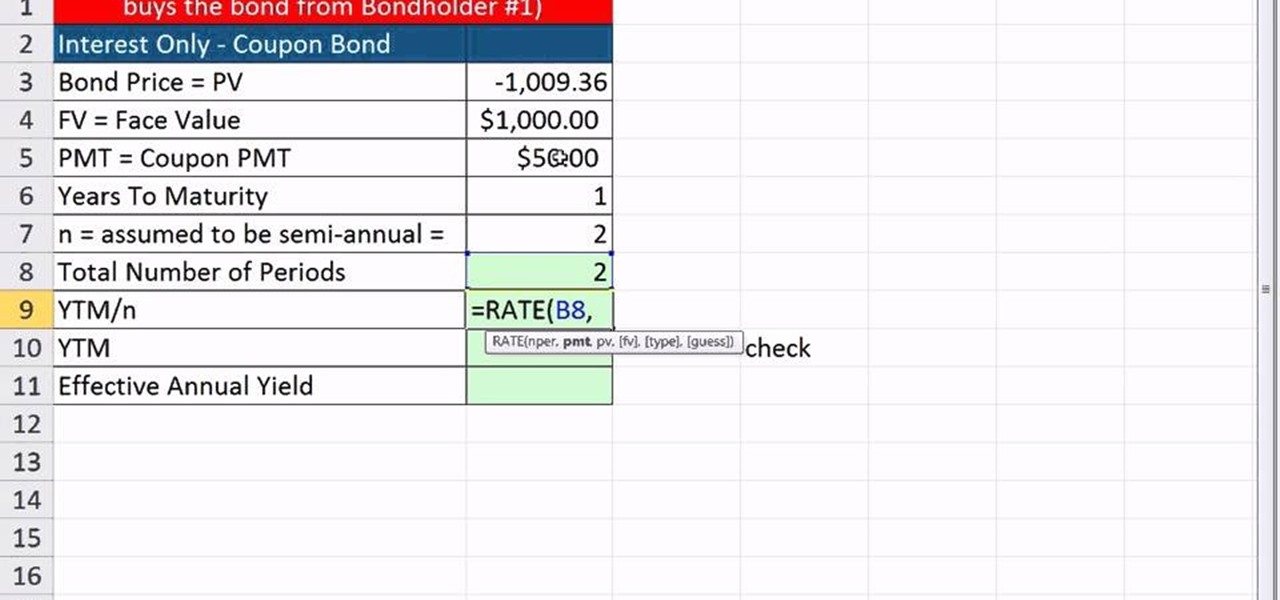


How To Calculate Ytm And Effective Annual Yield From Bond Cash Flows In Excel Microsoft Office Wonderhowto



Stata Codes For Calculating Yield To Maturity For Coupon Bonds Stataprofessor


Q Tbn And9gcs8pllmjk Cwco2cxddqmohomgedhyw Veiacyoq Lypi38bu2o Usqp Cau



Free Bond Valuation Yield To Maturity Spreadsheet


Cost Of Debt Definition Formula Calculation Example



Quant Bonds Yield



Ytm Formula Excel



Stata Codes For Calculating Yield To Maturity For Coupon Bonds Stataprofessor



Bond Valuation Wikipedia



Calculate The Ytm Of A Coupon Bond Youtube


1



Bond Yield To Maturity Calculator For Comparing Bonds



Yields To Maturity On Zero Coupon Ronds Bond Math



Calculating The Yield To Maturity Ytm Of A Bond Financial Management



Berk Chapter 8 Valuing Bonds



Ppt Yield To Maturity Formula Powerpoint Presentation Free Download Id



Yield To Maturity Ytm And Yield To Call Ytc alectures Com
:max_bytes(150000):strip_icc()/dotdash_Final_Current_Yield_vs_Yield_to_Maturity_Nov_2020-02-10d2adc981ea475eb2165a5ec13082ed.jpg)


Current Yield Vs Yield To Maturity



How To Calculate Yield For A Callable Bond Fox Business



21 Cfa Level I Exam Learning Outcome Statements



Yield To Call Definition Formula How To Calculate Yield To Call Ytc



Yield To Maturity Ytm Overview Formula And Importance



Vba To Calculate Yield To Maturity Of A Bond
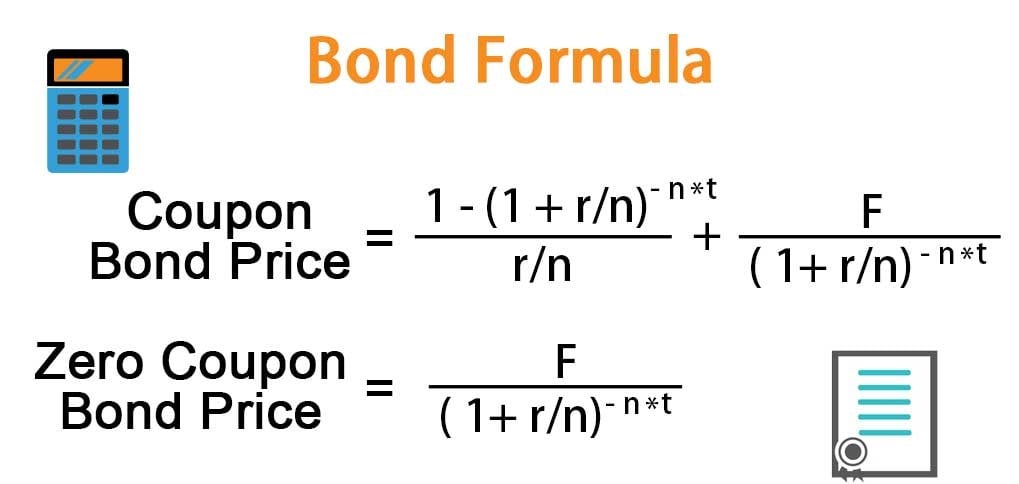


Bond Formula How To Calculate A Bond Examples With Excel Template
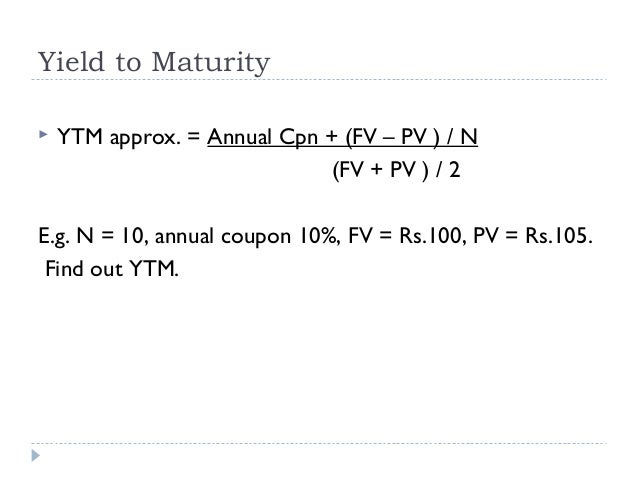


Bond Valuation



Yield To Maturity Ytm Overview Formula And Importance



Vba To Calculate Yield To Maturity Of A Bond
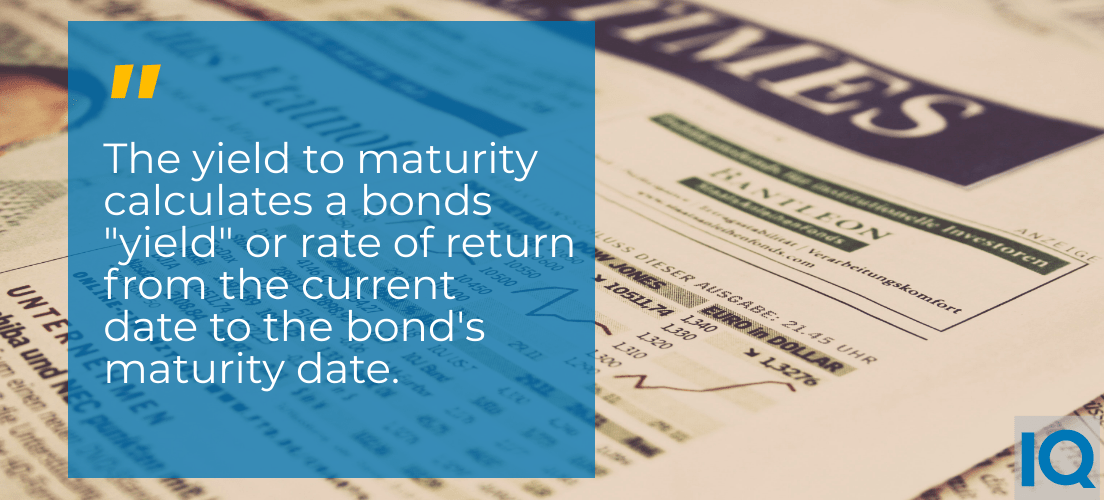


Yield To Maturity Calculator Bond Yield Calculator


High Yield Bonds
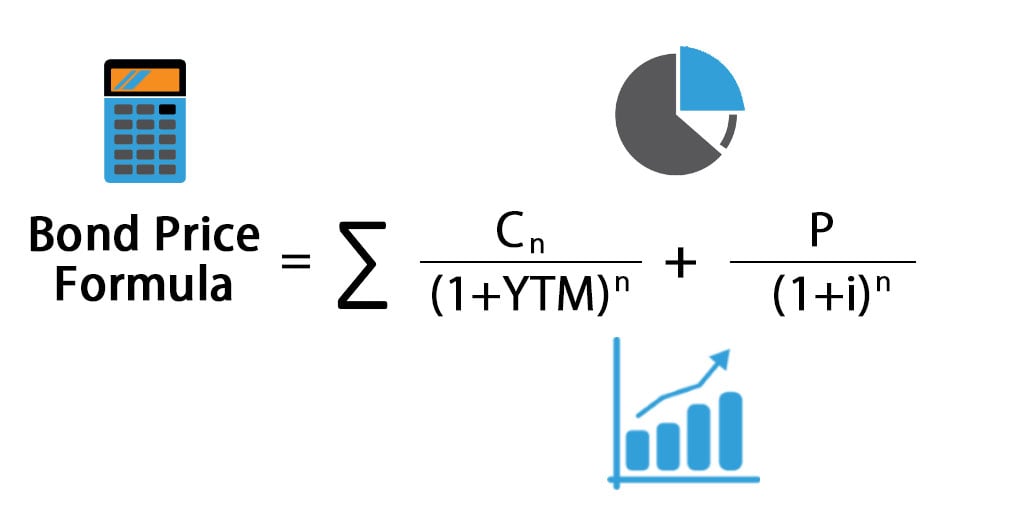


Bond Pricing Formula How To Calculate Bond Price
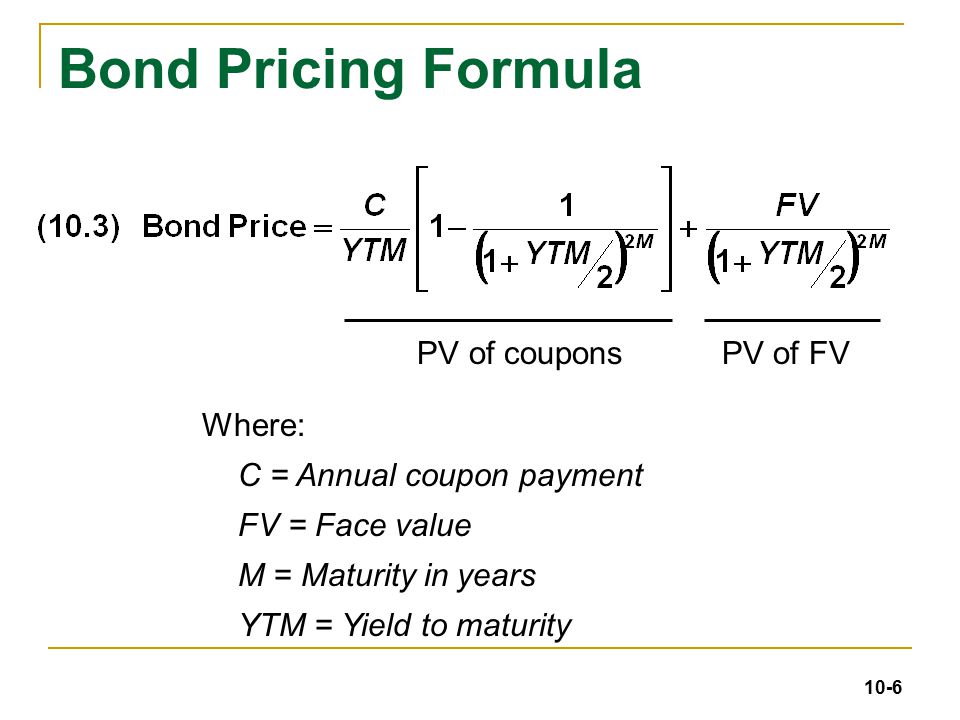


Chapter 10 Bond Prices And Yields 4 19 Ppt Download



How To Calculate Yield To Maturity Definition Equation Example Financial Accounting Class Video Study Com
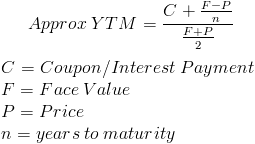


Yield To Maturity Approximate Formula With Calculator



Bond Basics Bond Yields Flashcards Quizlet



How To Calculate Yield To Maturity Definition Equation Example Financial Accounting Class Video Study Com



Best Tax Free Bonds For In India Should You Invest
:max_bytes(150000):strip_icc()/dotdash_Final_Current_Yield_Oct_2020-01-7b25f37332ff434f9bc3794782fe38fe.jpg)


Current Yield



Bond Valuation And Bond Yields P4 Advanced Financial Management Acca Qualification Students Acca Global
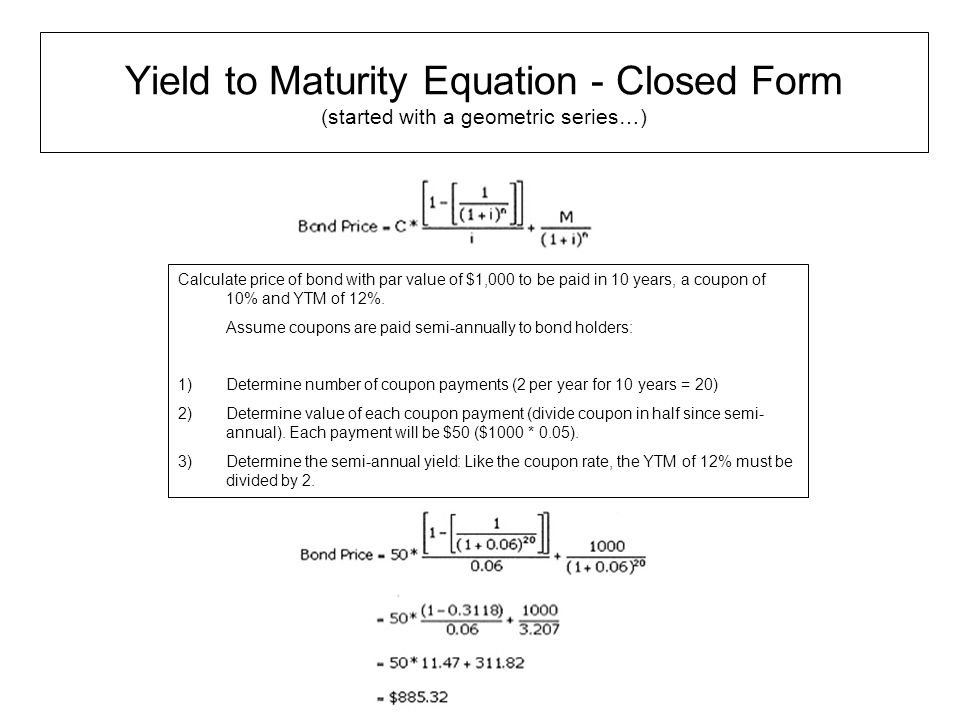


Yield To Maturity Formula Ppt Download
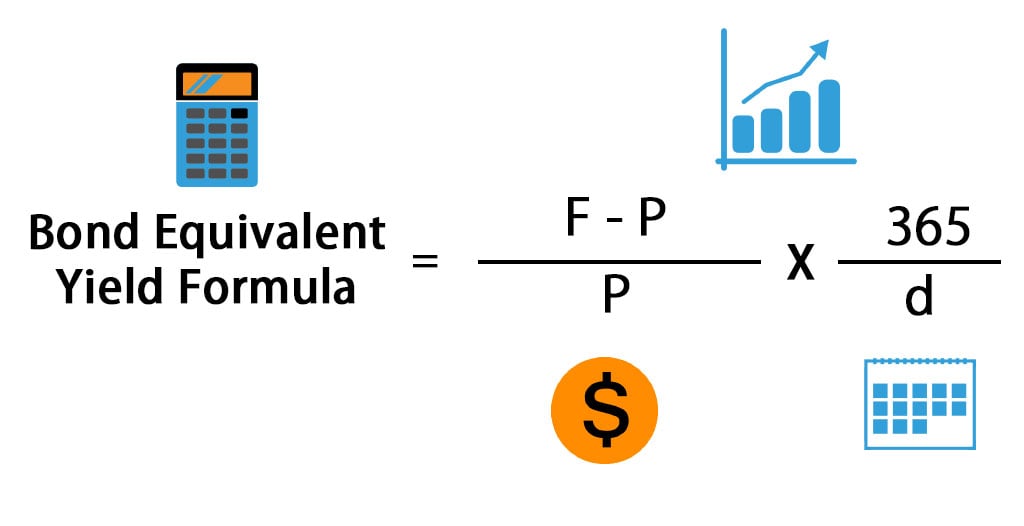


Bond Equivalent Yield Formula Calculator Excel Template



Yield To Maturity Ytm Definition Formula Calculations In Debt Mutual Fund Nippon India Mutual Fund
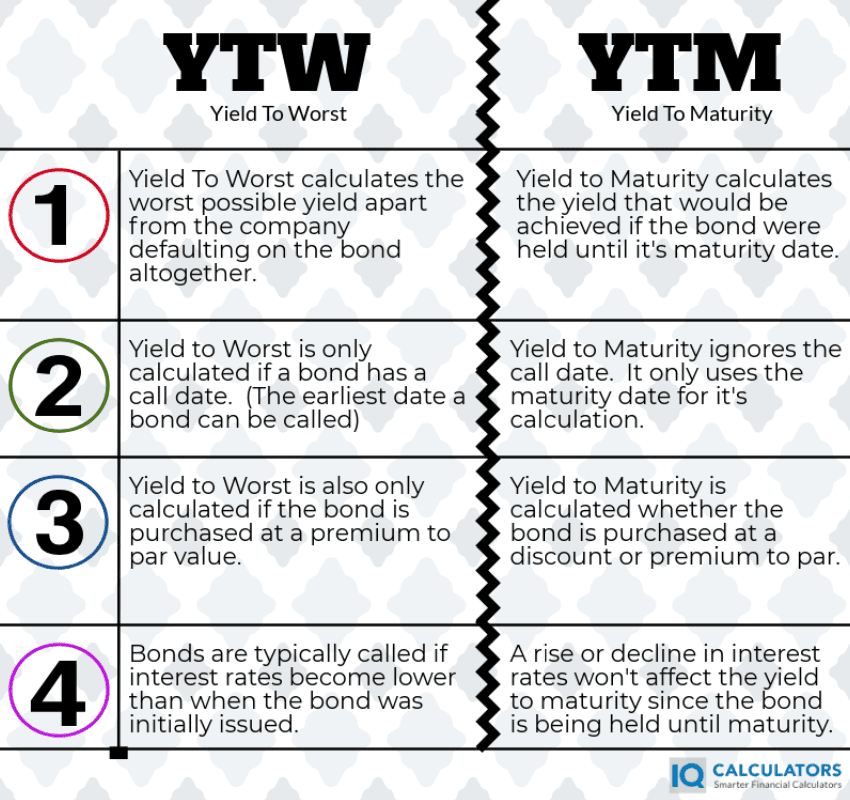


Yield To Worst What It Is And Why It S Important



Yield To Maturity Fixed Income



What Is The Difference Between Irr And The Yield To Maturity The Motley Fool



Interest Rate Risk Of Bonds Full Valuation Approach Aka Scenario Analysis



How To Calculate Yield To Maturity In Excel With Template Exceldemy



Yield To Maturity Definition How To Calculate Ytm Pros Cons


Yield To Maturity Ytm Definition Formula Method Example Approximation Excel



Coupon Rate Vs Yield Rate For Bonds Wall Street Oasis
/dotdash_Final_Yield_to_Worst_YTW_Oct_2020-01-cabc0d0cf5b64ef0b4f72afb4888b3aa.jpg)


Yield To Worst Ytw Definition



Yield To Maturity Formula Step By Step Calculation With Examples


Q Tbn And9gcqx2rkld6ury5os8uirtcnc50sedadn8kmuq3amc Qqkndcoxwv Usqp Cau



Thorough Description Of Yield To Maturity Personal Finance Money Stack Exchange



Yield To Maturity For Bond Valuation For Ca Final Sfm Video Classes Online Satellite Offline Youtube



What Is Yield To Maturity How To Calculate It Scripbox



Yield Function Formula Examples Calculate Yield In Excel



Bonds Yield To Maturity Example 1 Youtube



Calculating The Yield Of A Coupon Bond Using Excel Youtube



Yield To Maturity Formula Step By Step Calculation With Examples


コメント
コメントを投稿